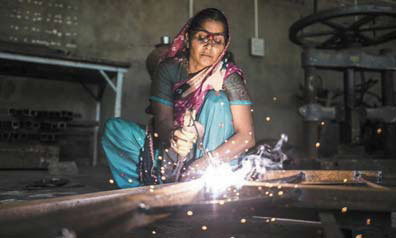'Barefoot' grandmas engineer solar revolution
An unpaved, dusty road lined with bushes and shrubs leads to a sprawling campus and a large classroom filled with solar panels and equipment. Here, Geeta Devi, a 45-year-old woman, is explaining a complicated-looking circuit to a group of awestruck women standing around a worktable.
Devi is a solar engineer - or a "barefoot" solar engineer, one of hundreds of women in their late thirties and forties, most of them grandmothers from some of the most remote corners of India - trained by the Barefoot College to build solar panels and provide off-grid villages with power.
Apart from lighting up villages, the program has also become an important tool for empowering rural women. Devi's life has undergone a sea change. From her formerly unremarkable existence tending the fields, livestock and her family, she is now financially independent thanks to her role teaching at the college.
|
At Barefoot College in Tilonia, India, rural women learn to make and maintain solar panels, bringing clean power to their villages and creating employment for locals. Lars Boland / For China Daily |
Barefoot College was founded in the early 1970s by social activist Sanjit "Bunker" Roy, and it has been teaching solar electrification since 1989. It works out of Tilonia, a small, sleepy village in the desert state of Rajasthan.
Starting with local women and spanning out to the rest of India, the Barefoot imprint currently reaches 64 other countries.
"The policy of the Barefoot College is to reach every last man or woman," Roy said.
Most of the teaching still happens in Tilonia. Every year, the college trains 100 women from India and 80 from Asia, Africa and Latin America in two batches for six months each.
The Indian government recognized the course in 2008 and covers the students' training and travel costs. The Ministry of External Affairs pays about 150,000 rupees ($2,500) in travel costs for each international grandmother, while the Ministry of New and Renewable Energy pays roughly 70,000 rupees for each domestic trainee. Funding from private individuals and foundations helps pay for solar equipment and other costs.
Spread over two sprawling campuses - the newer one fully solar-powered - the Barefoot College started by teaching both men and women. But by 2005, Roy realized the model would work best if they trained women alone.
"For a long-term, sustainable solution, training older women is a wise investment in human resources. They will stay in the village and are not interested in looking for jobs in the city," he pointed out.
The international students study in the old campus, about a kilometer from the new one. Joselyn Mateo Diaz, a 41-year-old grandmother from the Dominican Republic, traveled all the way to India this spring to learn how to equip her village with solar power. Her neighboring village was recently electrified.
"The government forgot about us," said Diaz. "My only wish is to study with my grandchild at night."
And soon she will. Diaz, who taught herself to read, has no problem following the lessons as they are carried out in basic English and through color-coded circuits and sign language. Back home, the villagers will pay a nominal monthly stipend to cover her services as well as components and spare parts for the panels.
"We kept the Barefoot model simple so it could be managed, controlled and owned by the community themselves," Roy said.
Globally, 1.3 billion people are off-grid. Of these, more than 300 million live in India, where the national electrification rate is 75 percent and rural electrification lags behind at 67 percent. More worryingly, about 800 million Indians are still dependent on carbon-emitting and polluting fuels.
To date, there are close to 750 Barefoot solar grandmothers around the world, and they have powered some 1,160 villages. This translates to a reduction of nearly 13 metric tons of carbon emissions per day and an annual savings of 500,000 liters of kerosene.
(China Daily 06/20/2015 page5)















